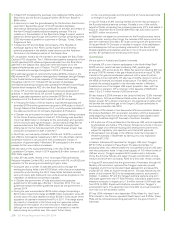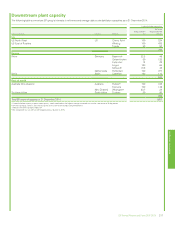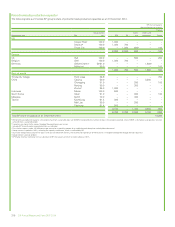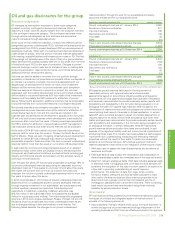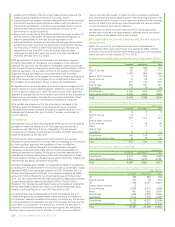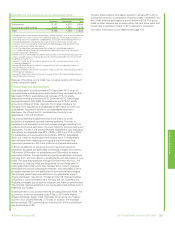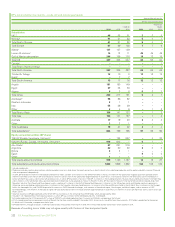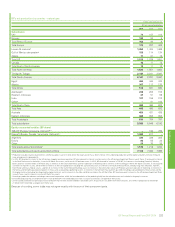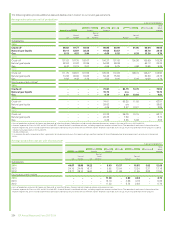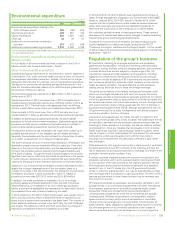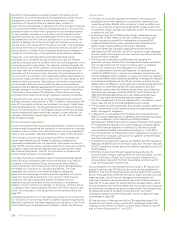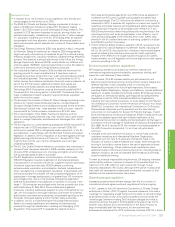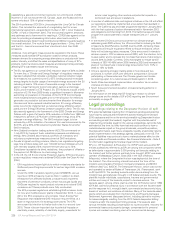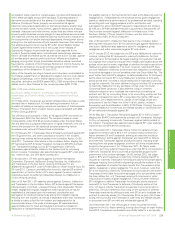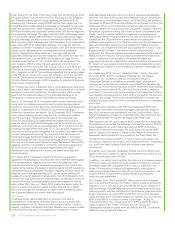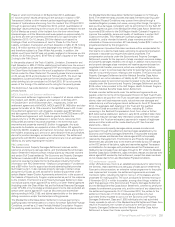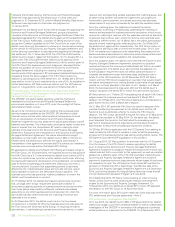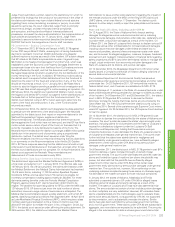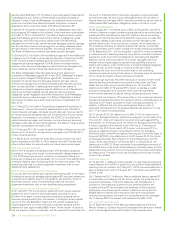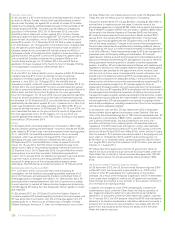BP 2014 Annual Report Download - page 230
Download and view the complete annual report
Please find page 230 of the 2014 BP annual report below. You can navigate through the pages in the report by either clicking on the pages listed below, or by using the keyword search tool below to find specific information within the annual report.
according to these agreed ownership interests. Ownership of joint-
arrangement or co-owned property and hydrocarbons to which the joint
arrangement or co-ownership is entitled is also shared in these
proportions. To the extent that any liabilities arise, whether to
governments or third parties, or as between the joint arrangement parties
or co-owners themselves, each joint arrangement party or co-owner will
generally be liable to meet these in proportion to its ownership interest.
In many upstream operations, a party (known as the operator) will be
appointed (pursuant to a joint operating agreement) to carry out day-to-
day operations on behalf of the joint arrangement or co-ownership. The
operator is typically one of the joint arrangement parties or a co-owner
and will carry out its duties either through its own staff, or by contracting
out various elements to third-party contractors or service providers. BP
acts as operator on behalf of joint arrangements and co-ownerships in a
number of countries where it has exploration and production activities.
Frequently, work (including drilling and related activities) will be
contracted out to third-party service providers who have the relevant
expertise and equipment not available within the joint arrangement or the
co-owning operator’s organization. The relevant contract will specify the
work to be done and the remuneration to be paid and will typically set out
how major risks will be allocated between the joint arrangement or co-
ownership and the service provider. Generally, the joint arrangement or
co-owner and the contractor would respectively allocate responsibility for
and provide reciprocal indemnities to each other for harm caused to their
respective staff and property. Depending on the service to be provided,
an oil and gas industry service contract may also contain provisions
allocating risks and liabilities associated with pollution and environmental
damage, damage to a well or hydrocarbon reservoir and for claims from
third parties or other losses. The allocation of those risks vary among
contracts and are determined through negotiation between the parties.
In general, BP incurs income tax on income generated from production
activities (whether under a licence or PSA). In addition, depending on the
area, BP’s production activities may be subject to a range of other taxes,
levies and assessments, including special petroleum taxes and revenue
taxes. The taxes imposed on oil and gas production profits and activities
may be substantially higher than those imposed on other activities, for
example in Abu Dhabi, Angola, Egypt, Norway, the UK, the US, Russia
and Trinidad & Tobago.
Environmental regulation
Current and proposed fuel and product specifications, emission controls,
climate change programmes and regulation of unconventional oil and gas
extraction under a number of environmental laws may have a significant
effect on the production, sale and profitability of many of BP’s products.
There are also environmental laws that require BP to remediate and
restore areas affected by the release of hazardous substances or
hydrocarbons associated with our operations. These laws may apply to
sites that BP currently owns or operates, sites that it previously owned or
operated, or sites used for the disposal of its and other parties’ waste.
See Financial Statements – Note 21 for information on provisions for
environmental restoration and remediation.
A number of pending or anticipated governmental proceedings against
certain BP group companies under environmental laws could result in
monetary or other sanctions. Group companies are also subject to
environmental claims for personal injury and property damage alleging
the release of, or exposure to, hazardous substances. The costs
associated with future environmental remediation obligations,
governmental proceedings and claims could be significant and may be
material to the results of operations in the period in which they are
recognized. We cannot accurately predict the effects of future
developments, such as stricter environmental laws or enforcement
policies, or future events at our facilities, on the group, and there can be
no assurance that material liabilities and costs will not be incurred in the
future. For a discussion of the group’s environmental expenditure see
page 225.
A significant proportion of our fixed assets are located in the US and the
EU. US and EU environmental, health and safety regulations significantly
affect BP’s operations. Significant legislation and regulation in the US and
the EU affecting our businesses and profitability includes the following:
United States
• The Clean Air Act (CAA) regulates air emissions, permitting, fuel
specifications and other aspects of our production, distribution and
marketing activities. Stricter limits on sulphur in fuels will affect us in
future, as will actions on greenhouse gas (GHG) emissions and other
air pollutants. States may also have separate, stricter air emission laws
in addition to the CAA.
• The Energy Policy Act of 2005 and the Energy Independence and
Security Act of 2007 affect our US fuel markets by, among other
things, imposing renewable fuel mandates and imposing GHG
emissions thresholds for certain renewable fuels. States such as
California also impose additional fuel carbon standards.
• The Clean Water Act regulates wastewater and other effluent
discharges from BP’s facilities, and BP is required to obtain discharge
permits, install control equipment and implement operational controls
and preventative measures.
• The Resource Conservation and Recovery Act regulates the
generation, storage, transportation and disposal of wastes associated
with our operations and can require corrective action at locations
where such wastes have been disposed of or released.
• The Comprehensive Environmental Response, Compensation and
Liability Act (CERCLA) can, in certain circumstances, impose the entire
cost of investigation and remediation on a party who owned or operated
a site contaminated with a hazardous substance, or arranged for disposal
of a hazardous substance at a site. BP has incurred, or is likely to incur,
liability under the CERCLA or similar state laws, including costs attributed
to insolvent or unidentified parties. BP is also subject to claims for
remediation costs under other federal and state laws, and to claims for
natural resource damages under the CERCLA, the Oil Pollution Act of
1990 (OPA 90) (discussed below) and other federal and state laws.
CERCLA also requires hazardous substance release notification.
• The Toxic Substances Control Act regulates BP’s manufacture, import,
export, sale and use of chemical substances and products.
• The Occupational Safety and Health Act imposes workplace safety and
health requirements on BP operations along with significant process
safety management obligations.
• In May 2012, the US adopted the UN Global Harmonization System
(GHS) for hazard classification and labelling of chemicals and products,
with the modification of the Occupational Safety & Health
Administration (OSHA) Hazard Communication Standard. This requires
BP to reassess the hazards of all our chemicals and products against
new GHS criteria as adopted or modified by OSHA and to update
warning labels and safety data sheets accordingly by 1 June 2015.
• The US Department of Transportation (DOT) regulates the transport of
BP’s petroleum products such as crude oil, gasoline, petrochemicals
and other hydrocarbon liquids.
• The Maritime Transportation Security Act (MTSA), the DOT Hazardous
Materials (HAZMAT) and the Chemical Facility Anti-Terrorism Standard
(CFATS) regulations impose security compliance regulations on around
30 BP facilities.
• OPA 90 is implemented through regulations issued by the US
Environmental Protection Agency (EPA), the US Coast Guard, the DOT,
OSHA, the Bureau of Safety and Environmental Enforcement and
various states. Alaska and the West Coast states currently have the
most demanding state requirements.
As a consequence of the Deepwater Horizon incident, BP has become
subject to claims under OPA 90 and other laws and has established a
$20-billion trust fund for legitimate state and local government response
claims, final judgments and settlement claims, legitimate state and local
response costs, natural resource damages and related costs and
legitimate individual and business claims (see Gulf of Mexico oil spill on
page 36). BP is also subject to natural resource damages claims, claims
for civil penalties under the Clean Water Act, and numerous civil lawsuits
by individuals, businesses and governmental entities. The ultimate costs
for these claims cannot be determined at this time. For further
disclosures relating to the 2010 Deepwater Horizon oil spill, see Legal
proceedings on page 228.
BP has also been in discussions with the EPA regarding alleged CAA
violations at the Toledo refinery and the EPA has alleged certain CAA
violations at the Cherry Point refinery and the Carson refinery which BP
sold to Tesoro Corporation on 1 June 2013.
226 BP Annual Report and Form 20-F 2014


